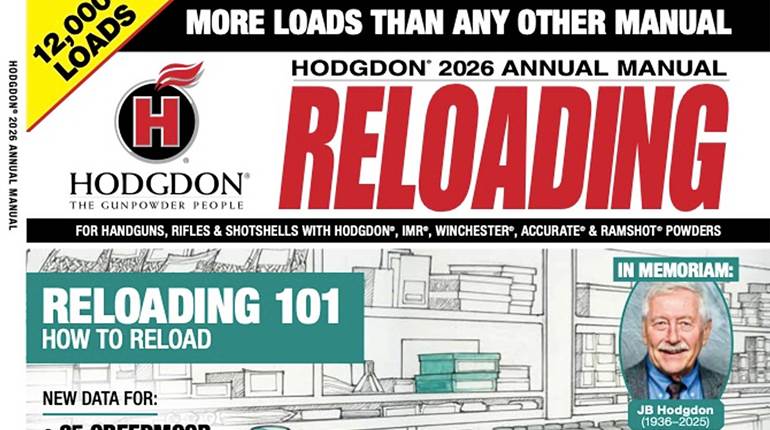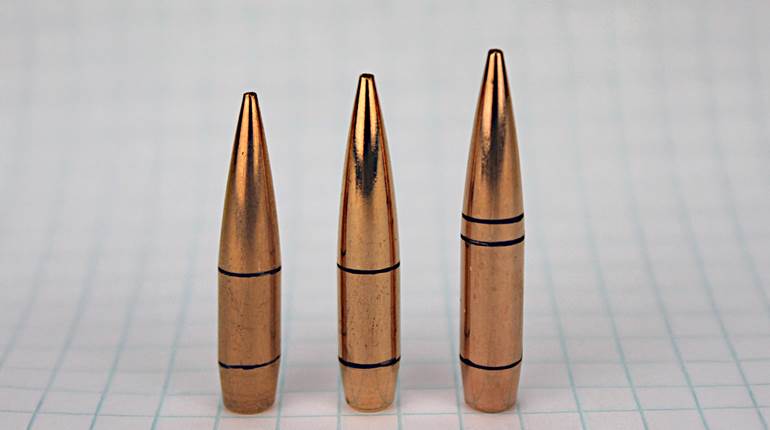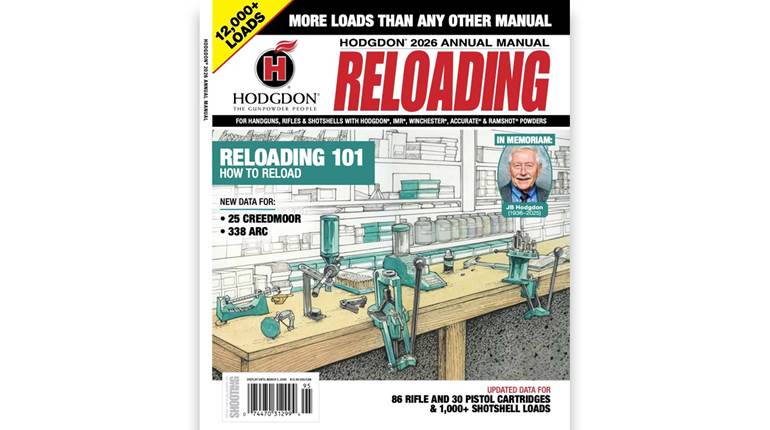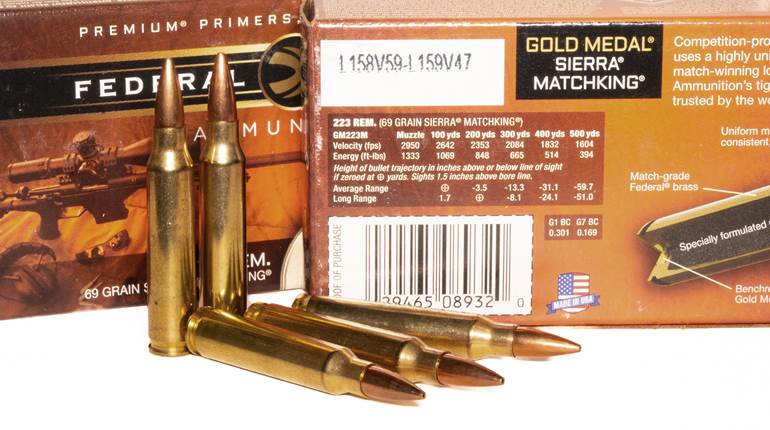
Nothing illustrates the individualistic American spirit more than a pioneer casting bullets over the heat of the evening campfire to handload cartridges on which the success of the following day’s hunt hinges. Down through the decades, that reliance on handloading has remained a way to save money, but the popularity of handloading does not stand on economy alone. Reloading rifle and handgun cases and shotshells also allows shooters to produce cartridges that meet special requirements and produce exact performance on targets and game. A plus, too, is the pleasure and satisfaction of producing your own ammunition with your own hands.
According to Will Hemeyer, senior product manager for RCBS, there are about 4 million handloaders. RCBS started manufacturing reloading equipment in 1943 when Fred Huntington, its founder, started making bullet swage tools from scrap automobile axles. The bullets were often shot at marmots, called rock chucks in the West, hence the name Rock Chuck Bullet Swage, or RCBS.
American shooters and hunters represent 95 percent of the handloading market, however, handloading is also somewhat popular in Germany and Australia. “Russia is becoming a fairly big market, too,” Hemeyer said.
COVID aside, January to April is the busy time of year for handloaders, as most of them are holed-up inside due to cold weather and are loading cartridges for summertime target matches, small-game hunting and fall hunting season. Four to six RCBS customer service representatives answer 6,000 phone calls and emails a month from customers with reloading questions.

Trends in handloading come and go. The big-game hunter who experiments with new bullets now and again and loads a few boxes of rifle cartridges a year remains a steadfast part of handloading, however, other segments of handloading have declined in recent years—most notably that of shotshell reloading. Owing to economies of scale, the price of a box of basic, factory-loaded 12-ga. 1-oz. target loads is less than the cost of components handloaders must buy to load the shotshells, especially lead shot, which costs upwards of $2 a pound. “About the only shotshell reloaders now are target shooters who want that one exact load for their shotgun and hunters making specialty loads like for pheasant hunting,” Hemeyer said. Shotshell reloading has diminished to the point that RCBS may discontinue its The Grand shotshell press. Bullet casting remains prevalent only among handloaders of those cartridges that lack commonly available projectiles. The difficulty of finding inexpensive lead and lead alloys—and the sun setting on the growth of cowboy action shooting—have also stalled the practice of bullet casting. The use of progressive presses to crank out volumes of handgun cartridges has also waned in recent years because of inexpensive factory-loaded cartridges such as 9 mm Luger.
Long-range rifle shooting has grown tremendously in the past few years. Publicity generated by more than a thousand professional-level competitors shooting the Precision Rifle Series has encouraged everyday shooters to try their hand at the long-range shooting game. “Everything changes, though, when you’re shooting 1,000 to over 1,300 yards,” Hemeyer said.

RCBS is catering to that precision-shooting market with new reloading tools. Specifically, handloading dies account for 90 percent of RCBS production at its Oroville, Calif., plant, where the company has been headquartered since 1958. The 6.5 mm Creedmoor is the darling cartridge of long-range shooters, and, as an indication of its popularity, RCBS currently makes in the neighborhood of 3,200 die sets a month for that chambering alone. According to Hemeyer, that’s more than for .308 Win. When I decided to pick a MatchMaster die set and MatchMaster Powder Scale/Dispenser to handload some .22-250 Rem. cartridges, it was partly to prove the point that there are cartridges in the world other than the 6.5 mm Creedmoor.
MatchMaster sizer die sets are available with either a Neck- or Full-Length Sizer die, and I chose to use a full-length die to size once-fired Nosler .22-250 cases. Uniformly sized cases require consistency from the beginning. To that end, I used an RCBS CaseMaster Gauging Tool to measure neck runout and case neck thickness of 30 of the Nosler cases before sizing them. Neck runout was nothing on most of the cases to 0.001" on a few. Case-neck thickness varied 0.001" or less on the majority to 0.002" on a few.
That consistent neck thickness is necessary to obtain a precise amount of tension on bullets. Standard sizer dies for bottleneck cases accommodate a range of neck thicknesses by forcing a case neck into the neck portion of the die and pulling an expander ball through the neck to set the final diameter as the case is withdrawn from the die. MatchMaster sizer dies, though, use a bushing to size necks an exact amount.

To select the correct diameter bushing for Nosler cases required measuring the outside neck diameter of a loaded cartridge and subtracting 0.002" to 0.003". That worked out to a 0.246"-diameter bushing, providing a perfect fit for Berger 55-grain FB Target bullets seated in the neck of Nosler cases. The advantages of sizing necks with a bushing are several. For one, work-hardening of brass is reduced. Second, constant neck tension on bullets narrows extreme spreads of velocity, which is important to reduce vertical spread of bullets at long range. Third, bullet seating depth is very uniform in matching case necks. I sized the necks of several brands of .22-250 cases in the MatchMaster die. While seating bullets in the different case brands, I felt varying amounts of resistance on the press handle, and the overall loaded length of the cartridges differed up to 0.06".

A few steps were required to set the die when sizing cases for a glove-fit in my Cooper Model 22 in .22-250 Rem. I measured the headspace of Nosler cases that had been fired in the rifle with a Hornady Lock-N-Load Headspace Comparator. I turned the die into the press a partial turn at a time, measuring with the Comparator until case shoulders were bumped back 0.002". A nickel placed on the shell holder, and held tight against the bottom of the die with upward pressure on the press ram, took the play out of the die body threads to square the die in the press, and I secured the die lock ring. Neck runout was next to nothing on most of the 30 sized cases. For some reason, runout was 0.005" on three cases, and running them through the sizer die again failed to straighten the necks.

Dispensing an exact amount of propellant into cases is another necessary handloading step in producing precise cartridges. The RCBS MatchMaster Powder Scale/Dispenser weighs propellant to ± 0.10 grains set in Standard mode or ± 0.040 grains in Match mode.
There was a learning curve when I first started weighing propellant with the MatchMaster. The first lesson learned was that its scale is sensitive. Hovering over it, the draft from my breath moved the displayed weight 0.6 of a grain. The furnace kicking on in the next room also stirred up the air enough to alter dispensing. To prevent vibrations that might disturb the scale, I leveled it on top of a solid, heavy bench and dispensed propellant to charge all the cases needed for that handloading session. I then took the tray of charged cases over to my bench-mounted press to seat the bullets.

Once the MatchMaster is turned on, it requires 15 minutes or so to warm up. When “Stable” appears on the display, it is ready to calibrate with a 20-gram weight followed by a 50-gram weight. Powder dispensers in the past were criticized for the minute or longer required to dole out a propellant charge. The MatchMaster significantly reduces that time with a large dispensing tube that quickly pours out most of a charge, then switches to a small tube to trickle in the last few grains to bring a charge up to the intended weight. A dispense speed is entered into the unit to keep dispense time short but not turn out an overcharge. Typically, extruded propellants are dispensed at the slower speeds, while spherical and flake-type propellants are dispensed at a faster rate.
My plan was to handload Hodgdon Varget with Berger 55-grain FB Target bullets together with Remington 9½ Large Rifle primers in Nosler .22-250 Rem. cases. I set the MatchMaster’s dispense speed on “2” and punched in 35.0 for the propellant weights in grains. In Standard mode, the measure took 16 seconds to dole out that amount of Varget. I lifted the scale pan, containing the charge, several times off and back on the scale plate. The scale correctly registered 35.0 grains each time. I poured the weighed Varget into a .22-250 case, and, with the MatchMaster set in the Auto dispense mode, the measure started to dispense another charge when the empty pan was placed back on the scale plate.
Set in the Match mode, the MatchMaster has a resolution of 0.020 grains with an accuracy of 0.040 grains over a range of 3.0 to 300.0 grains. In Match mode, the large dispensing tube poured out most of the propellant in a few seconds. The small tube took over from there, trickling a few kernels, stopping for a moment and trickling in the last few kernels—this took 30 seconds.
I stepped back to my reloading press with a loading block containing 10 cases filled with Varget weighed in Standard and 10 more weighed in Match mode. The MatchMaster seater die includes a floating bullet seat plug adjustable in 0.001" increments by turning a thimble on top of the die. An opening in the side of the die is the handiest feature, as a bullet can be dropped on top of the exposed sliding case guide, where it is held in alignment with a case entering the die.
To position the seater die in my press, I raised a .22-250 case to the top of the press stroke, turned the die down until it touched the case and backed the die back out a quarter turn. Once again using the nickel technique to eliminate play, I secured the die lock ring.
The Cooper .22-250 has a long chamber throat, and a cartridge length of 2.50" placed the Berger bullets fairly close to the start of the rifling. Ten cartridges placed on a CaseMaster Gauging Tool showed bullet runout of nothing to 0.001" on a few.
I shot the Standard and Match mode cartridges through the Cooper .22-250. The average of two, five-shot groups were:
There wasn’t much difference between the Standard and Match loads. However, standard deviation of velocity seemed rather high for both loads.
So back to the MatchMaster set in Match mode to weigh out 35.5 grains of IMR 8208 XBR in an attempt to lower the standard deviation. The machine churned out propellant for 32 seconds before it beeped to indicate that a charge had been dispensed. After dispensing, an exact weight was displayed. Five of them read 35.48, 35.54, 35.52, 35.52 and 35.50. Between the lightest and heaviest charges was a difference of only 0.06 of a grain, which is exact.
I shot the cartridges through the Cooper rifle on a blustery day. Three, five-shot groups averaged:
That is an accurate and consistent load producing less than an inch of vertical difference in trajectory at 500 yards between its slowest and fastest bullets. Some enjoyable work and a helping hand from RCBS went into meeting that goal.






































